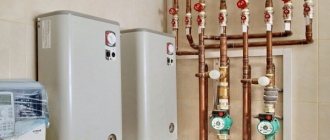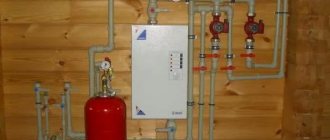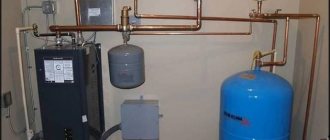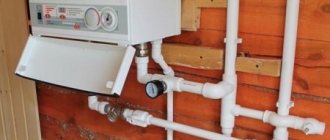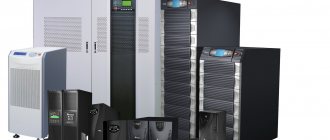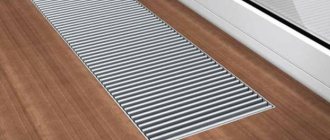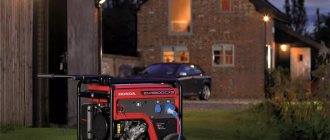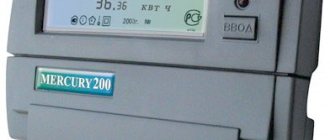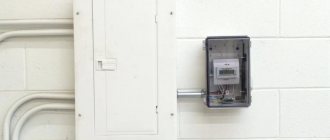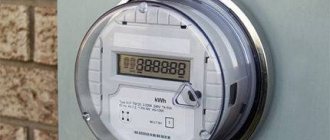Home / Electric boilers
Back
Published: 06/08/2019
Reading time: 6 min
0
2991
A growing number of social green movements around the world are demanding that governments pay due attention to environmental issues in their life support systems. In response to their demands, as an alternative to stove heating, models of economical electric boilers for heating a private home were released onto the market.
- 1 How relevant is the method of heating with an electric boiler?
- 2 Advantages of electric boilers
- 3 How to choose a good electric boiler 3.1 Power
- 3.2 Energy efficiency
The most economical electric boiler is a myth
Electricity is much easier to convert into heat than other energy sources - natural gas, solid fuel, diesel fuel. Here are 3 simple examples of heat by-products when using electricity:
- the windings of any operating electric motor always heat up;
- a light bulb (even an LED one) produces heat along with the light;
- Even the wires through which current flows become heated.
Please note that the equipment listed is designed to perform its functions, and not to heat the house. The motor rotates something, the lamp shines, the wiring supplies them with energy. The formation of excess heat is a side effect that occurs due to the resistance of these elements.
Spiral and induction heater converting electricity into heat with 99% efficiency
To convert all electrical energy into thermal energy, it is enough to create a high resistance section in the circuit, which itself will not collapse from heating. This element is called an electric heater. The second (more complex) way to obtain heat is to create Foucault induction eddy currents that heat a metal object in the area of action of the inductor coil.
Important point. Regardless of the conversion method, 98–99% of electricity will turn into heat. That is, any electric heating device operates with an efficiency of 98–99%, no less. This means that the most economical electric boiler does not exist; all units are equally efficient. No matter what home appliance sellers claim.
The main criteria for choosing electric boilers for a summer residence
When selecting an electric boiler for heating a dacha, the most important thing is to correctly select the optimal power of the device in order not to spend extra money and not freeze at low outside temperatures.
The power directly determines the size of the room the boiler can heat. If it will be used only for heating, the power is calculated from the ratio of 0.1 kW per 1 m2 of area.
To heat hot water, additional load will be required, based on the number of water users and the level of plumbing equipment in the house.
Method of installing an electric boiler at the dacha. Photo source: lipetsk.blizko.ru
In order to make a choice of an electric boiler, you will need to calculate the heat load at the dacha and take into account the following data:
- dimensions of the heated house;
- degree of thermal insulation of the object;
- building materials from which the structural elements of the building are made;
- existence/absence of a smoke ventilation system;
- number and characteristics of window and door openings;
- temperature characteristics of the region where the object is located.
Selection of heat generator by power
To select the power of an electric boiler, first of all, calculate the heat losses of your home. You probably know the approximate method of calculation: to heat 100 square meters of building area, a heating unit with a capacity of 10 kW is taken, for 200 m² - 20 kW, and so on. If you want to get a more reasonable result, use our calculation methods.
A very approximate calculation method - we divide the area of all rooms by 10, we get heat loss in kilowatts
Now let’s define the tasks that an electric boiler must solve (select the desired list item):
- round-the-clock heating of an apartment, cottage, country house;
- the same, with water heating for domestic needs;
- work at night at a cheap rate;
- standby heating – maintaining the air temperature +5…10 °C.
Note. Night heating of the house with an electric boiler can be combined with heating of the heat accumulator. At 7.00 the unit turns off, then the water system receives the heat accumulated in the buffer tank. 2 conditions: the allocated limit for electricity consumption must be 15...20 kW + powerful electric boiler.
Full heating with electricity is not cheap and is used as needed. A more profitable option is night heating from 23.00 pm to 7.00 am, when the cost of energy is half as much. The standby mode is used on objects under construction or dachas, where the owners spend 2-3 days weekly.
We select the power of the electric heating boiler depending on the tasks:
- For round-the-clock operation, the unit is selected with a margin of 10...20%. That is, the heat loss figure is multiplied by a factor of 1.1–1.2. For example, a house with an area of 60 square meters loses 4 kW, the productivity of the electric boiler will be 4 x 1.2 = 4.8 kW.
- For hot water supply (DHW), the power of the unit should be increased by 50%. That is, multiply the figure 4 kW from the example by a factor of 1.5 (we get 6 kW).
To obtain hot water, it is customary to connect a single-circuit electric boiler to an indirect heating boiler through a three-way valve. The latter switches the coolant between the tank and the heating system - An electric heating device for night heating can be taken without a power reserve if it is replaced in the morning by a gas or solid fuel boiler. Reducing the temperature to 18–19 °C during sleep will not cause much discomfort, but will save money.
- The power of the electric boiler that maintains positive temperatures in the building is taken with a reduction factor of 0.6–0.7 (minus 30–40%) of the amount of heat loss.
Advice. To organize DHW, you do not need to look for a double-circuit boiler. Usually there are 2 options: installing a separate electric water heater or a powerful heat generator plus an indirect heating boiler.
The performance of the heater for nightly “charging” of the heat accumulator depends on the volume of the tank and is calculated individually. The selection of an electric boiler under standard conditions is described in the video:
No. 8. The best manufacturers of electric boilers
There are dozens of manufacturers, both foreign and domestic, on the electric boiler market. European boilers usually have smooth adjustment and are assembled from more expensive components. Our boilers mainly have step adjustment, which is why they are cheaper. Probably, each of us understands well that it is better not to save on the heating system, so you should not trust little-known companies. The largest , proven and reliable manufacturers of electric boilers in the world and Russia:
- Protherm is a Czech manufacturer that started with the production of electric boilers. Today, other types of heating boilers are produced, as well as boilers, thermostats, etc. The company's electric boilers are wall-mounted, power from 6 to 28 kW, efficiency 99.5%, and are available in a single-circuit version. In 2001, the company became part of the German Vaillant group of companies;
- Vaillant produces slightly more expensive boilers than Protherm, power up to 28 kW, all models are easy to use and reliable;
- Buderus is a large German company that produces electric boilers for private homes and commercial properties, the power of wall-mounted single-circuit models is 30-60 kW;
- Kospel are reliable Polish electric boilers, available in a wide range. Power from 4 to 36 kW, models up to 8 kW are presented in two versions, for working with a network of 220 V and 380 V;
- Bosch also produces electric boilers, power from 4 to 24 kW, wall-mounted, with one circuit, but it is possible to connect an indirect heating boiler. You can buy either a simple boiler or a boiler complete with an expansion tank and pump;
- Ferroli are high-quality Italian electric boilers with a power from 6 to 28 kW with very well-thought-out automation and a wide range of additional functions. The boilers have connectors for connecting room and street temperature sensors, a large display, the ability to daily program the operation of the boiler and even control the boiler using the remote control;
- ZOTA are domestic boilers that are distinguished by the most affordable price and fairly high-quality performance. Power from 3 to 400 kW, boilers are presented in several lines, heating elements are used as heaters;
- RusNIT - good budget boilers from a Ryazan company, power from 3 to 99 kW;
- Evan is a large domestic manufacturer, part of the NIBE concern, producing boilers in different price segments. Power from 2.5 to 480 kW.
It is also worth noting the products of the companies Dakon, ACV and RECO, Intois, Alvin, Resurs.
Complete set of heating units
We have already listed the elements of any electric boiler in the basic, cheapest configuration. This is a heating unit, thermostat, automation with an actuator, controls and a temperature sensor.
An important nuance. In budget versions of boilers, the executive element is a magnetic starter. It clicks loudly when the heating is turned on, the sound is clearly audible in the rooms adjacent to the boiler room.
In an extended configuration, manufacturers supply electric boilers with the following equipment:
- low-noise modular contactor instead of a magnetic starter;
- circulation pump;
- membrane expansion tank for a closed heating system;
- overheating and coolant pressure sensors;
- safety group – automatic air vent, safety valve;
- circulation sensor – for induction heat generators;
- weather automatics;
- LCD display, programmer, GSM remote control module from a smartphone.
Naturally, the “fat” equipment of an electric boiler will cost much more than the “poor” one. On the other hand, you will still have to buy an expansion tank, a pump and a safety group. It is much more convenient to install the unit when these elements are hidden inside the housing.
Which electric boiler to choose - recommendations
In 90% of cases, we recommend choosing an electric boiler with heating elements. These are reliable devices that are equally suitable for different heating systems - radiators, heated floors, floor or baseboard convectors. Select the level of staffing based on the conditions of installation, operation and the allocated budget.
A few more tips:
- For your apartment, definitely take a wall-mounted electric mini-boiler room, equipped with heating elements, its own pump and tank.
- If the electric boiler must work in tandem with a solid fuel or gas unit, it is better to choose a model without a built-in pump and expansion tank. The specified equipment is connected separately - the tank works for the entire system, the pump is controlled by a room thermostat, as shown in the diagram.
It is more convenient to operate the circulation pump when it is located separately from the boiler - Install a remote thermostat. Then the boiler will focus on the temperature of the air, and not the coolant.
- Choose an electrode heat generator in 3 cases: limited budget, too little space in the boiler room, or connection to a gravity heating circuit without a pump.
- Electrode units create the least problems in open systems - the resulting gases safely escape through the atmospheric expansion tank.
- Choose an induction boiler according to your desire and availability of funds. But keep in mind: operating experience has shown that the specified device is no better than a heating element. No special technical problems were noted with induction heaters, only financial ones.
Comment. An electrode-type boiler for a gravity system must have pipes of the appropriate diameter (minimum Ø32 mm), the supply pipe is directed upward.
For a water heated floor, only an electric heating element boiler is suitable. It is difficult for induction and electrode units without stepwise heating to maintain a low water temperature in floor circuits - 35...45 °C.
Types of electric boilers for home heating
There are several types of electric boilers based on the principle of electricity use and operation. Traditional and familiar to everyone - heating elements. More innovative and energy-saving are induction (vortex) and ionic (electrode), they are more expensive, but the cost is paid off by extreme efficiency and efficiency, which weakly or does not decrease at all over time.
The efficiency of all electric boilers is the same - 94–99%, but some types are more efficient due to the design and method of operation. And also over time, due to scale, this characteristic decreases by 10–20% for heating element boilers, but this is not typical for induction and ionic products.
Types of electric boilers:
- with heating elements;
- ionic (heating by electrodes);
- induction (vortex).
Heating elements new electric boilers
Heating boilers with heating elements can only be classified as economical only conditionally: different models may have more efficient heating elements, programming capabilities, and power settings.
Inside the device there is a tubular electric heater - a copper or stainless steel tube (there may be sand or oil inside) with a filament (nichrome). The principle of operation is the same as that of a conventional boiler or air heater: the spiral inside the shell heats up and transfers heat through the tube in which it is enclosed to the water entering the chamber (flask) with the heating element.
When choosing electric heating for a home with a special emphasis on economy, units with heating elements should not be seriously considered. You can choose a high-quality device with more or less energy consumption, but it will still be more power-hungry than induction and ion boilers. On the other hand, the cost reduction can be compared to some extent, since a boiler with a heating element is cheap to maintain.
Advantages and disadvantages of heating elements electric boilers
Advantages of heating heaters with heating elements:
- cheap and convenient repair (the body is easily disassembled, parts are replaceable);
- advanced functionality: power adjustment, programmability, ability to connect a thermostat;
- usually produced in a monoblock compact case (there are convenient wall-mounted sizes) ready for operation, including a safety group, expansion tank, and pump. There is no need to separately purchase and install these elements; you only need to connect the device to the input and output of the heating system.
Minuses:
- the most uneconomical type of electric boilers, especially if two heating elements are used;
- Scale and plaque forms on the heating element, which requires periodic cleaning and replacement. A hard crust reduces efficiency by 10–20%. This statement is controversial, since the water of the heating system is not prone to intense scale formation, but it should not be ignored.
Induction boilers
Types of induction boilers for home heating (sometimes perceived as brand names):
- VIN - “vortex induction heaters”, more innovative with a ferromagnetic body. Smaller in size and 1.5–2 times more expensive than SAV, but more efficient;
- SAV - the principle is the same, but they are positioned as less advanced.
The second heating with vortex boilers is “inverter”. The product includes a current converter from direct to alternating current - an “inverter” (like welding machines).
Immediately after their appearance on the market, induction heaters for heating were positioned as the most advanced and efficient, but application experience showed more shortcomings than expected.
Operating principle of vortex SAV and VIN electric boilers
How does an induction SAV boiler work:
- A high-frequency alternating current (from 50 Hz) is supplied to a metal coil (inductor) - a rod (its role can be played by the coolant pipe itself) with turns of wire. A magnetic field is generated.
- The polarity and vector of the magnetic field change with high frequency.
- An object located close to the described phenomenon is penetrated by constantly changing fluxes of magnetic induction. Foucault eddy currents arise, turning electricity into heat, which heats the water.
The principle of heat transfer in induction boilers is non-contact - the object is heated by electromagnetic fields, and instantly. There is no need for physical contact with the inductor, which increases efficiency.
The electromagnetic principle is used in industry to melt metals. Even a small homemade induction device with a coil with a dozen turns and a few cm² in size is capable of heating metal to red in a few seconds, which illustrates the power and efficiency of a vortex boiler for heating.
Advantages of induction boilers for heating
Advantages of SAV boilers:
- heating is powerful, almost instantaneous;
- microvibrations repel dirt, so there is no scale or deposits on parts in contact with water, no cleaning required;
- economical, the highest efficiency among electric boilers.
Induction boilers are the best for preparing water as it flows through the apparatus, as they provide extremely fast heating. At the same time, heat loss is zero, which distinguishes VIN from heating elements units. Despite the disadvantages, if we consider purely the efficiency of using electricity, induction boilers are the most economical type of electric heaters.
Disadvantages of vortex boilers for heating, feasibility of use
Many sources list many advantages of VINs and SAVs, but in reality the picture is somewhat different; many shortcomings have been discovered:
- most standard sizes have significant dimensions;
- more expensive than heating elements and electrode units;
- heating is extremely powerful, so if the auto-shutdown system breaks down, there is an increased risk of explosion;
- the electromagnetic field is harmful, electrochemical processes provoke corrosion;
- complex repair. It would seem that the device is extremely simple - a coil and a housing - but usually the cylinder of SAV boilers is securely sealed, and it is extremely difficult to disassemble it. It contains electronic circuits of the control unit, which complicates repairs. The coil may burn out, and the cost of a new one is higher than, for example, a new heating element;
- if the SAV is not in a compact case, and the majority are, then a large control unit, a separate expansion tank, a pump, and a safety group will be required;
- in most cases, they are not equipped with a soft start - when turned on and even when simply switching modes, there is a sharp increase in the load on the network, which is fraught with voltage drops (flashing lights and similar effects).
Still, despite the listed disadvantages, a vortex energy-saving electric heating boiler should be considered as a heater for heating a house due to its high level of efficiency (30% more efficient than heating elements). Some of the listed disadvantages are relative, for example, there are small and compact sizes similar to those of products with heating elements. This is the only type of heater whose efficiency does not decrease over time.
Ion (electrode) boilers
Ionic (electrode) energy-saving heating boilers must be distinguished from induction units, despite the fact that they also use the properties of alternating current. The organization of energy use itself is different. The body of the device contains a sealed chamber with a coolant and electrodes located in it with a certain gap.
With a constant current, the cathode attracts water ions with a positive charge, and the anode attracts negative ones, but if you change the characteristic to a variable one (starting from 50 Hz), then a constant movement of these particles will occur. The medium has resistance, so the kinetic energy of moving ions (cations and anions) is transformed into thermal energy, and the electrolyte is heated.
In the ion boiler, a special electrolyte solution is heated, circulating in the pipes of the heating system; in certain cases it can be water. In fact, such a boiler is a simple heat exchanger.
Advantages of ion (electrode) boilers for heating systems
Advantages and features of ion boilers for heating:
- extremely compact: low-power models are only slightly larger than the diameter of the pipes. This is a small cylinder cut into the wiring. They do not require any space around them, so they can be installed literally anywhere;
- the cheapest - 4–9 thousand rubles. (A new heating element costs about 15-30 thousand), but if you have to buy an expansion tank, thermostat, safety valves, pump, then it’s another 10-12 thousand;
- scale does not form - this is prevented by electromagnetic processes;
- service life before the first breakdown is 12–15 years. According to this characteristic, electrode heaters are comparable to induction devices;
- maintainability. The design is simple and can be disassembled without much difficulty. Parts are replaceable and cheap;
- the safest: if induction or heating element boilers, if the automatic shutdown (protection against overheating and dry operation) fails, continue to heat up until an explosion or fire, then ionic boilers will simply stop working on their own without any intervention if the coolant leaks;
- no electromagnetic field.
Disadvantages of electrode heaters
Installation of the electrode device itself is simple, but it is somewhat complicated by the need to install a pump, safety group, and expander. There are also products with the last two elements on the body or in the form of a ready-to-use monoblock, but this arrangement is less common. In this aspect, heating element boilers have an advantage, since they are often produced in standard sizes with everything necessary in one housing.
Minuses:
- There are devices with a heat exchanger and an expansion tank on the body, but in most cases an additional purchase of these elements is required, as well as a pump and safety group;
- scale and plaque do not form, but electrical processes increase corrosion of the metal of the heating system circuit. In this aspect there is a similarity with SAV boilers;
- Pipe water can act as an electrolyte, but usually special solutions from the manufacturers of such boilers are always used. The mixture must be undistilled and unfiltered. Special substances are the most effective. Propylene glycol and ethylene glycol are used. You cannot use antifreeze, oil, or distilled water;
- requires replacement of the coolant every 3–4 years.
Electrode boilers consume 20–30% less electricity than heating element units, but they are slightly less energy efficient than induction models. That is, in the economy rating, if we take into account the convenience, low cost of the product and service, they are in the middle.
Finally, about energy consumption
The natural desire of a homeowner is to know how much electricity an electric boiler will consume when heating a private home. Unfortunately, actual consumption cannot be predicted. The indicator is too individual and depends on a number of factors - the degree of insulation, the temperature maintained inside, the weather.
Monthly consumption can be calculated approximately: take 50% of the estimated heat loss of the house, multiply by 24 hours and 30 days. Example: losses are 6 kW, half - 3 kW, per day 3 x 24 = 72 kW, per month - 72 x 30 = 2160 kW. Why we take ½ power: during the season the weather is not always cold, the warmer it is outside, the more often the electric boiler turns off.
An example from personal experience. A house of 100 m² is heated at night with a 9 kW electrode boiler for 8 hours, the region is southern. Over 6 months of the heating season, the electric boiler consumed 9104 kW. Average monthly energy consumption is 1517 kW, average daily energy consumption is 1517 / 30 = 50.6 kW.
Types of devices based on the heating principle and their description
Below are the main types of boilers operating on the principle of energy conservation:
- heating elements . They are equipped with a tubular-type heating element that heats the moving liquid.
- Induction . The principle of their operation is based on magnetic induction. In this case, the ferromagnetic alloy is heated inside the coolant.
- Electrode (ionic) . Units of this type combine advanced developments with a high degree of efficiency. They heat water by passing an electric current through an electrolyte solution. Its molecules are converted into cations and anions. The result of this process is the release of a significant amount of thermal energy.
Single-circuit and double-circuit
An electric heating boiler can be one of two main types:
- Single-circuit . Designed for heating rooms by circulating liquid inside radiators and in a closed circuit.
- Dual-circuit . They can not only heat your home. but also provide it with hot water supply. They are compact and some can be placed on the wall.
Advantages and disadvantages
The advantages of different types of energy-saving boilers are approximately the same and are as follows:
- Very high efficiency - up to 99 percent.
- During operation of such a device, soot and ash are not released, and oxygen is not burned out of the air.
- The equipment operates completely autonomously.
- Easy installation, management and maintenance.
- Minimum noise level during operation.
- High level of safety due to automatic power supply shutdown when there is no liquid in the heat exchanger.
- Relatively low price level in comparison with gas heating equipment.
- There is no need to install a chimney or arrange a place to store coal or firewood.
The list of main disadvantages looks like this:
- Electric shock hazard.
- Special requirements for the quality of water used for heat exchange. In case of non-compliance, the equipment will not last long.
Features of operation of electrode boilers
Advantages:
- high efficiency indicators - at least 95% efficiency;
- good environmental friendliness;
- combination of high power with small overall dimensions;
- is not afraid of electrical voltage surges.
Flaws:
- the need to use alternating power supply;
- periodic monitoring of electrolyte conductivity;
- arrangement of reliable grounding;
- you need to install a pump to circulate water in the heating system;
- Electrodes need to be replaced every 2-4 years.
Features of electrode heating boilers Numerous reviews will help you choose the best models of electrode boilers for heating a private home.
The efficiency of such units is due to the excellent shock-absorbing system and the use of economical fuel. No maintenance required. Electrode equipment has a longer service life.
